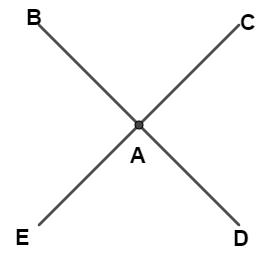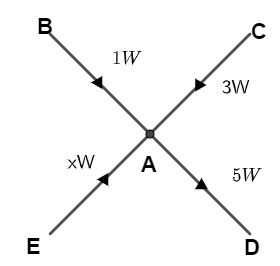
Four identical rods which have thermally insulated lateral surfaces are joined at point A. Points B,C,D & E are connected to large reservoirs. If heat flows into the junction from point B at rate of $1W$ and from point ‘C’ at $3W$ inside, flows out from D at $5W$, which relation (s) is//are correct for temperature of these points ?

(A) ${T_A} < {T_E}$
(B) ${T_B} = {T_C}$
(C) ${T_C} > {T_D}$
(D) ${T_B} = {T_E}$
Answer
221.4k+ views
Hint: In order to solve this question, we will first equate the total rate of heat flowing into point A and the total rate of heat flowing out of point B and then we will check each option for temperature relations at every four points.
Complete answer:
Let us assume the rate of heat flow through the rod EA be $xW$ into the point A and draw the rough diagram to represent the heat flow direction at each rod as

Now, total heat flowing into the point A is $(1 + 3 + x)W$ and the net flow of heat out of the point A is $5W$ now, equate both values we get,
$
1 + 3 + x = 5 \\
x = 1W \\
$
Now, since heat is flowing from point E to A which means
$
{T_E} > {T_A} \\
\Rightarrow {T_A} < {T_E} \\
$
So, option (A) is correct
Since, heat is flowing out of the point A to D but going into the point A from C which means
$
{T_C} > {T_A} > {T_D} \\
\Rightarrow {T_C} > {T_D} \\
$
So, option (C) is correct.
Since rate of heat flow is equal in rods BA and EA so, we have
$
{T_B} - {T_A} = {T_E} - {T_A} \\
{T_B} = {T_E} \\
$
So, option D is also correct.
But, ${T_B} \ne {T_C}$ so option (B) is incorrect.
Hence, the correct options are (A), (C), and (D)
Note:It should be remembered that, heat energy always flows from higher temperature point to the lower temperature point and for a closed system net heat flowing into the junction point is always equals to the net heat flowing out of the junction point.
Complete answer:
Let us assume the rate of heat flow through the rod EA be $xW$ into the point A and draw the rough diagram to represent the heat flow direction at each rod as

Now, total heat flowing into the point A is $(1 + 3 + x)W$ and the net flow of heat out of the point A is $5W$ now, equate both values we get,
$
1 + 3 + x = 5 \\
x = 1W \\
$
Now, since heat is flowing from point E to A which means
$
{T_E} > {T_A} \\
\Rightarrow {T_A} < {T_E} \\
$
So, option (A) is correct
Since, heat is flowing out of the point A to D but going into the point A from C which means
$
{T_C} > {T_A} > {T_D} \\
\Rightarrow {T_C} > {T_D} \\
$
So, option (C) is correct.
Since rate of heat flow is equal in rods BA and EA so, we have
$
{T_B} - {T_A} = {T_E} - {T_A} \\
{T_B} = {T_E} \\
$
So, option D is also correct.
But, ${T_B} \ne {T_C}$ so option (B) is incorrect.
Hence, the correct options are (A), (C), and (D)
Note:It should be remembered that, heat energy always flows from higher temperature point to the lower temperature point and for a closed system net heat flowing into the junction point is always equals to the net heat flowing out of the junction point.
Recently Updated Pages
Uniform Acceleration Explained: Formula, Examples & Graphs

JEE Main 2022 (July 26th Shift 1) Physics Question Paper with Answer Key

JEE Main 2022 (June 26th Shift 2) Chemistry Question Paper with Answer Key

Apparent Frequency Explained: Formula, Uses & Examples

JEE Main 2023 (January 30th Shift 2) Chemistry Question Paper with Answer Key

JEE Main 2023 (April 15th Shift 1) Physics Question Paper with Answer Key

Trending doubts
JEE Main 2026: Application Form Open, Exam Dates, Syllabus, Eligibility & Question Papers

Derivation of Equation of Trajectory Explained for Students

Hybridisation in Chemistry – Concept, Types & Applications

Understanding the Angle of Deviation in a Prism

How to Convert a Galvanometer into an Ammeter or Voltmeter

Degree of Dissociation: Meaning, Formula, Calculation & Uses

Other Pages
JEE Advanced Marks vs Ranks 2025: Understanding Category-wise Qualifying Marks and Previous Year Cut-offs

Thermodynamics Class 11 Physics Chapter 11 CBSE Notes - 2025-26

Units And Measurements Class 11 Physics Chapter 1 CBSE Notes - 2025-26

NCERT Solutions For Class 11 Physics Chapter 8 Mechanical Properties Of Solids

Motion in a Straight Line Class 11 Physics Chapter 2 CBSE Notes - 2025-26

Laws of Motion Class 11 Physics Chapter 4 CBSE Notes - 2025-26




